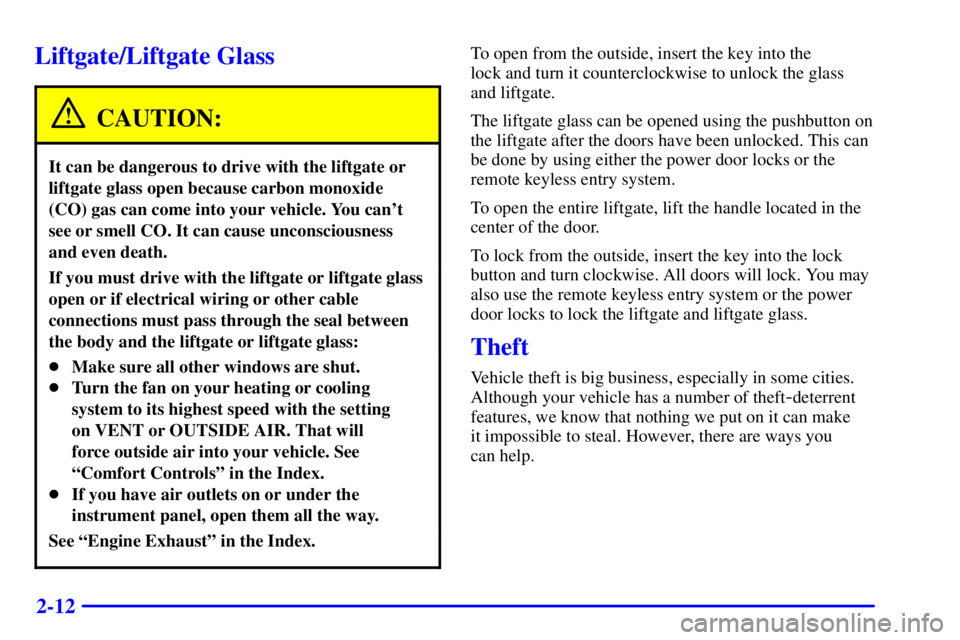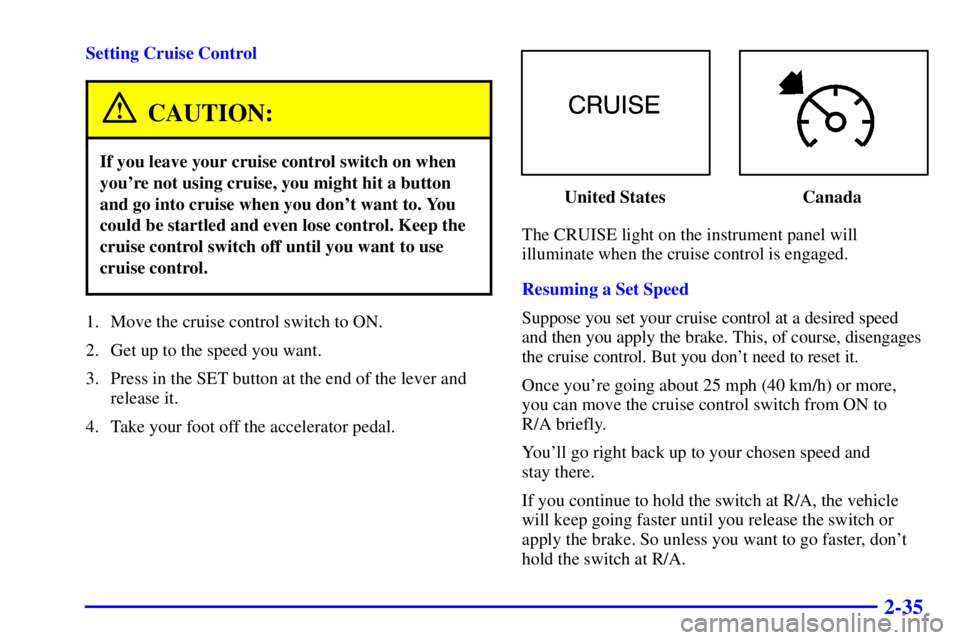Page 99 of 394

2-12
Liftgate/Liftgate Glass
CAUTION:
It can be dangerous to drive with the liftgate or
liftgate glass open because carbon monoxide
(CO) gas can come into your vehicle. You can't
see or smell CO. It can cause unconsciousness
and even death.
If you must drive with the liftgate or liftgate glass
open or if electrical wiring or other cable
connections must pass through the seal between
the body and the liftgate or liftgate glass:
�Make sure all other windows are shut.
�Turn the fan on your heating or cooling
system to its highest speed with the setting
on VENT or OUTSIDE AIR. That will
force outside air into your vehicle. See
ªComfort Controlsº in the Index.
�If you have air outlets on or under the
instrument panel, open them all the way.
See ªEngine Exhaustº in the Index.
To open from the outside, insert the key into the
lock and turn it counterclockwise to unlock the glass
and liftgate.
The liftgate glass can be opened using the pushbutton on
the liftgate after the doors have been unlocked. This can
be done by using either the power door locks or the
remote keyless entry system.
To open the entire liftgate, lift the handle located in the
center of the door.
To lock from the outside, insert the key into the lock
button and turn clockwise. All doors will lock. You may
also use the remote keyless entry system or the power
door locks to lock the liftgate and liftgate glass.
Theft
Vehicle theft is big business, especially in some cities.
Although your vehicle has a number of theft
-deterrent
features, we know that nothing we put on it can make
it impossible to steal. However, there are ways you
can help.
Page 107 of 394

2-20
Automatic Transmission Operation
There are several different positions for your shift lever.
Your vehicle is equipped with an automatic transmission
and features an electronic shift position indicator located
within the instrument panel cluster. This display is
powered anytime the shift lever is capable of being
moved out of PARK (P). This means that if your key is
in OFF, rather than LOCK, there will be a small current
drain on your battery which could discharge your battery
over a period of time. If you have to leave your key in
the ignition in OFF for an extended period, it is
recommended that you remove the IGN 0 fuse from the
instrument panel fuse block. See ªFuses and Circuit
Breakersº in the Index.PARK (P): This position locks your rear wheels. It's the
best position to use when you start your engine because
your vehicle can't move easily.
CAUTION:
It is dangerous to get out of your vehicle if the
shift lever is not fully in PARK (P) with the
parking brake firmly set. Your vehicle can roll.
Don't leave your vehicle when the engine is
running unless you have to. If you have left the
engine running, the vehicle can move suddenly.
You or others could be injured. To be sure your
vehicle won't move, even when you're on fairly
level ground, always set your parking brake and
move the shift lever to PARK (P).
See ªShifting Into PARK (P)º in the Index. If
you're pulling a trailer, see ªTowing a Trailerº in
the Index.
Page 118 of 394

2-31
Turn Signal/Multifunction Lever
The lever on the left side of the steering column
includes the following:
�Turn and Lane Change Signals
�Headlamp High/Low
-Beam Changer
�Flash
-to-Pass feature
�Windshield Wipers
�Windshield Washer
�Cruise Control
Turn and Lane Change Signals
The turn signal has two upward (for right) and two
downward (for left) positions. These positions allow you
to signal a turn or a lane change.
To signal a turn, move the lever all the way up or down.
When the turn is finished, the lever will return automatically.
An arrow on the instrument
panel cluster will flash in
the direction of the turn or
lane change.
To signal a lane change, just raise or lower the lever
until the arrow starts to flash. Hold it there until you
complete your lane change. The lever will return by
itself when you release it.
If you move the lever all the way up or down, and the
arrow flashes at twice the normal rate, a signal bulb
may be burned out and other drivers may not see your
turn signal.
If a bulb is burned out, replace it to help avoid an
accident. If the arrows don't go on at all when you
signal a turn, check for burned
-out bulbs and a blown
fuse (see ªFuses and Circuit Breakersº in the Index).
Page 119 of 394

2-32
Turn Signal On Chime
If your turn signal is left on for more than 3/4 of a mile
(1.2 km), a chime will sound at each flash of the turn
signal. To turn off the chime, move the turn signal lever
to the off position.
Headlamp High/Low-Beam Changer
To change the headlamps from low to high beam or high
to low beam, pull the multifunction lever all the way
toward you. Then release it.
When the high beams
are on, this light on the
instrument panel also
will be on.
Flash-to-Pass Feature
This feature allows you to use your high-beam
headlamps to signal a driver in front of you that you
want to pass. It works even if your headlamps are off.
To use it, pull the turn signal lever toward you, but not
so far that you hear it click.If your headlamps are off or on low beam, your
high
-beam headlamps will turn on. They'll stay on as
long as you hold the lever toward you and the high
-beam
indicator on the instrument panel will come on. Release
the lever to turn the high
-beam headlamps off.
Windshield Wipers
You control the windshield wipers by turning the band
with the wiper symbol on it.
For a single wiping cycle, turn the band to MIST. Hold
it there until the wipers start, then let go. The wipers will
stop after one wipe. If you want more wipes, hold the
band on MIST longer.
You can set the wiper speed for a long or short delay
between wipes. This can be very useful in light rain or
snow. Turn the band to choose the delay time. The
closer to LO, the shorter the delay.
For steady wiping at low speed, turn the band away
from you to the LO position. For high
-speed wiping,
turn the band further, to HI. To stop the wipers, move
the band to OFF.
Be sure to clear ice and snow from the wiper blades
before using them. If they're frozen to the windshield,
carefully loosen or thaw them. If your blades do become
worn or damaged, get new blades or blade inserts.
Page 120 of 394

2-33 Windshield Washer
There is a paddle marked with the windshield washer
symbol at the top of the multifunction lever. To spray
washer fluid on the windshield, push the paddle. The
wipers will clear the window and then either stop or
return to your preset speed.
CAUTION:
In freezing weather, don't use your washer until
the windshield is warmed. Otherwise the washer
fluid can form ice on the windshield, blocking
your vision.
Rear Window Washer/Wiper
This knob is located on the
instrument panel.
To turn the rear wiper on, turn the knob to either ª1º
or ª2º. For long delayed wiping, turn the knob to 1.
For short delayed wiping, turn the knob to 2. To turn the
wiper off, turn the knob to 0.
To wash the window, press the knob.
The rear window washer uses the same fluid bottle as
the windshield washer. However, the rear window
washer will run out of fluid before the windshield
washer. If you can wash your windshield but not your
rear windows, check the fluid level.
For more information, see ªLow Washer Fluidº in
the Index.
Page 122 of 394

2-35
Setting Cruise Control
CAUTION:
If you leave your cruise control switch on when
you're not using cruise, you might hit a button
and go into cruise when you don't want to. You
could be startled and even lose control. Keep the
cruise control switch off until you want to use
cruise control.
1. Move the cruise control switch to ON.
2. Get up to the speed you want.
3. Press in the SET button at the end of the lever and
release it.
4. Take your foot off the accelerator pedal.
United States Canada
The CRUISE light on the instrument panel will
illuminate when the cruise control is engaged.
Resuming a Set Speed
Suppose you set your cruise control at a desired speed
and then you apply the brake. This, of course, disengages
the cruise control. But you don't need to reset it.
Once you're going about 25 mph (40 km/h) or more,
you can move the cruise control switch from ON to
R/A briefly.
You'll go right back up to your chosen speed and
stay there.
If you continue to hold the switch at R/A, the vehicle
will keep going faster until you release the switch or
apply the brake. So unless you want to go faster, don't
hold the switch at R/A.
Page 124 of 394

2-37
Exterior Lamps
Your parking lamp and headlamp knob is on the driver's
side of your instrument panel.
Turn the knob clockwise to the parking lamps symbol to
manually turn on:
�Parking Lamps
�Sidemarker Lamps
�Taillamps
�License Plate Lamps
�Instrument Panel LightsTurn the knob clockwise to the master lamps symbol to
turn on all the lamps listed as well as the headlamps.
Turn the knob all the way counterclockwise to turn
off your lamps and put the system into automatic
headlamp mode.
You can switch your headlamps from high to low beam
by pulling on the turn signal/high
-beam lever.
Automatic Headlamp System
When it is dark enough outside, your automatic
headlamp system will turn on your headlamps at the
normal brightness along with other lamps such as the
taillamps, sidemarker, parking lamps and the instrument
panel lights. The radio lights will also dim.
Your vehicle is equipped with a headlamp off delay,
which will keep the headlamps on for a short time after
the ignition is turned to OFF. For more information see
ªSecondary Information Center (SIC)º in the Index.
Your vehicle has a light sensor located on the top of
the instrument panel in the defroster grille. Be sure it
is not covered, or the system will be on whenever the
ignition is on.
The system may also turn on your headlamps when
driving through a parking garage, heavy overcast
weather or a tunnel. This is normal.
Page 126 of 394

2-39
When the DRL are on, only your DRL lamps will be on.
The taillamps, sidemarker and other lamps won't be on.
The instrument panel won't be lit up either.
When it begins to get dark, the automatic headlamp
system will switch from DRL to the headlamps or the
last chosen headlamp setting that was used.
When you turn the headlamp knob to off, the headlamps
will go off, and your DRL lamps will illuminate,
provided it is not dark outside.
To idle your vehicle with the DRL off, set the parking
brake. Shifting the transmission into PARK (P) will also
allow you to idle the vehicle with the DRL off. The
DRL will stay off until you release the parking brake or
shift the transmission out of PARK (P).This procedure applies only to vehicles first sold in the
United States.
When necessary, you may turn off the automatic
headlamp system and the Daytime Running Lamps
(DRL) feature by following these steps:
1. Turn the ignition to RUN.
2. Press the DOME OVERRIDE button four times
within six seconds. After the fourth press of the
button, a chime will sound informing you the system
is off.
3. The system will revert back to the automatic mode
when the DOME OVERRIDE button is again pushed
four times within six seconds (a chime will sound),
or when the ignition is turned off and on again.
When the system is turned off, the headlamps will not
automatically come on when it becomes dark outside.
As with any vehicle, you should turn on the regular
headlamp system when you need it.